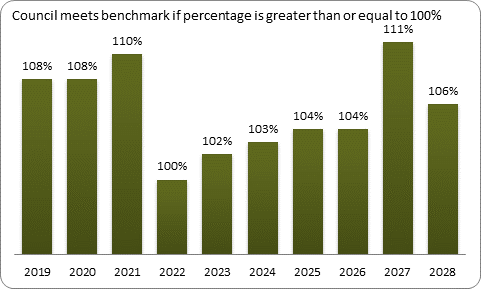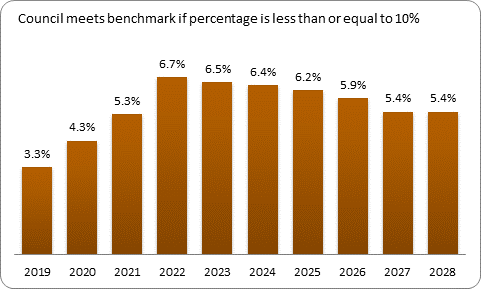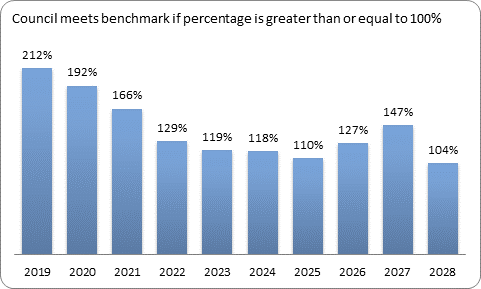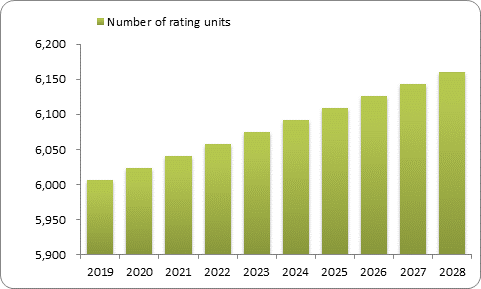Forecast Benchmarks
This profile shows the Council's forecast financial management benchmarks and total rating units over a 10 year period. This information has been collected by the Department of Internal Affairs from the Council's current Long-Term Plan (LTP).
The following displays the Council's forecast balanced budget benchmark for each of the ten years of the LTP. The balanced budget percentage represents the Council's planned revenue (excluding development contributions, financial contributions, vested assets, gains on derivative financial instruments and revaluations of property, plant or equipment) as a proportion of planned operating expenses (excluding losses on derivative financial instruments and revaluations of property, plant or equipment). The Council meets this benchmark if its planned revenue equals or is greater than its planned operating expenses.
Forecast balanced budget benchmark
All figures are percentages (%), as at year ended 30 June 2019 - 2028.
- Source
- The Council's 2018-2028 Long-Term Plan.
The following displays the Council's forecast debt servicing benchmark for each of the ten years of the LTP. The debt servicing percentage represents the Council's planned borrowing costs as a proportion of planned revenue (excluding developmet contributions, financial contributions, vested assets, gains on derivative financial instruments and revaluations of property, plant or equipment). The Council meets this benchmark if its planned borrowing costs equal or are less than 10% of its planned revenue, if the Council's projected population growth is less than or equal to the country's projected growth. If the Council's projected population growth is greater than the country as a whole, the benchmark is set at 15% of planned revenue.
Forecast debt servicing benchmark
All figures are percentages (%), as at year ended 30 June 2019 - 2028.
- Source
- The Council's 2018-2028 Long-Term Plan.
The following displays the Council's forecast essential services benchmark for each of the ten years of the LTP. The essential services percentage represents the Council's planned capital expenditure on network services as a proportion of expected depreciation on network services. The Council meets this benchmark if its planned capital expenditure on network services equals or is greater than expected depreciation on network services.
Forecast essential services benchmark
All figures are percentages (%), as at year ended 30 June 2019 - 2028.
- Source
- The Council's 2018-2028 Long-Term Plan.
The following chart shows the Council's projected number of rating units for each of the ten years of the LTP.
Forecast rating units
All numbers are as at year ended 30 June 2019 - 2028.
- Source
- The Council's 2018-2028 Long-Term Plan.
Notes
- All years presented are as at 30 June.
- Values for benchmark indicators are percentages. Values for rating units are unrounded whole numbers.
- If a chart and table are missing values, either the Department was not able to source this information from the Council's published LTP; or, the Council does not produce the information (e.g. due to having no debt).
- The forecast is for the Council alone. It does not include data for any council-controlled organisation.
- The figures do not include any amendments that may have been made by the Council after the LTP was adopted, such as in subsequent annual plans.
- Each Council has adopted different assumptions. The key assumptions are generally about demographics, inflation and spending intentions. For details about the specific assumptions adopted by this Council please refer to their LTP.
- As each council’s LTP may be presented differently, the Department of Internal Affairs has interpreted the data from the LTP statements against a consistent framework as described in the "Data Dictionary" for this dataset.
- The “Download Data” section of this website provides a consolidated set of councils’ LTP financial data in Excel pivot table format, as well as the "Data Dictionary" and further notes about this dataset.
- While care has been used in extracting, processing and analysing councils’ LTP data, the Department of Internal Affairs is not responsible for the currency or accuracy of this information. The Department of Internal Affairs disclaims and excludes all liability for any claim, loss, demand or damages of any kind whatsoever (including for negligence) arising out of, or in connection with, the use of this information.



